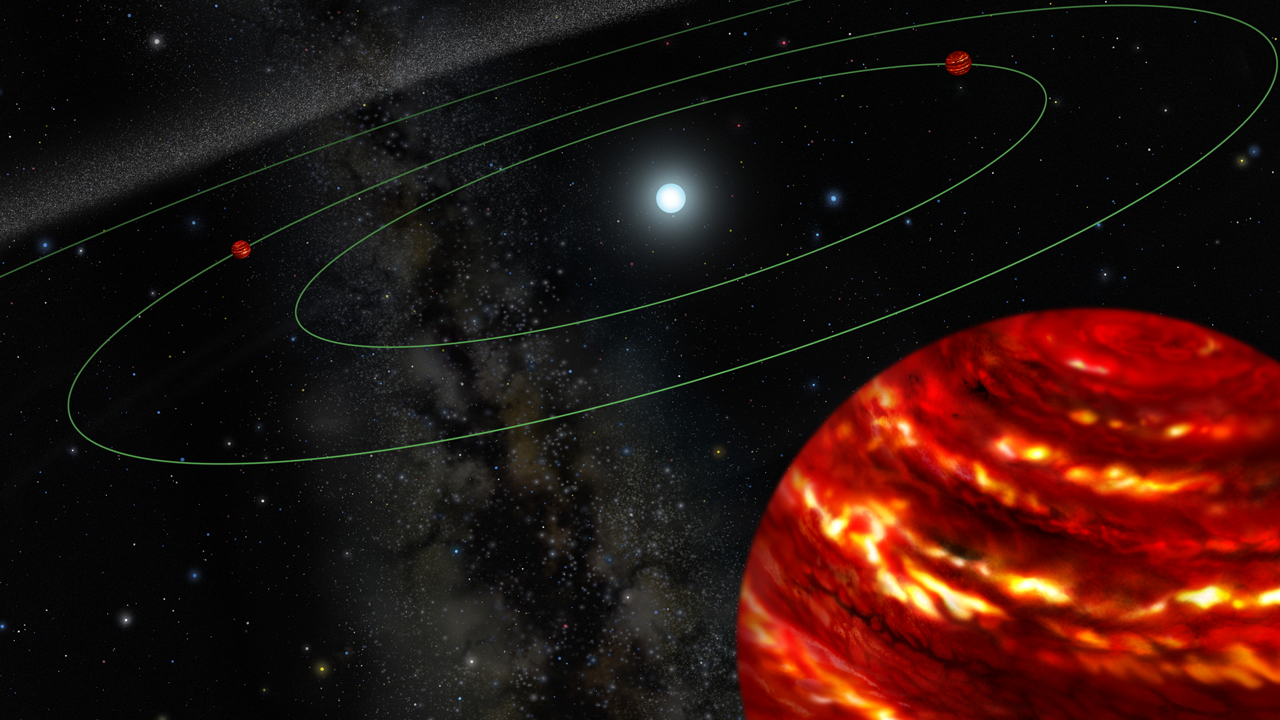
An artist’s conception of the HR 8799 system. Gemini Observatory/AURA illustration by Lynette Cook.
The extraordinary sensitivity of the Large Binocular Telescope (LBT) in southeastern Arizona has revealed the architecture of a young stellar system whose structure promises to shed light on how our own solar system formed and help answer questions about the number and locations of Earth-like planets.
An international team of astrophysicists, including Professor Chick Woodward of the University of Minnesota’s Minnesota Institute for Astrophysics, studied the planetary system called HR 8799, which is only 30 million years old and 130 light-years away, in the northern constellation Pegasus. The findings are the first results from the LEECH (LBT Exozodi Exoplanet Common Hunt) survey and were published April 20, 2015, in the journal Astronomy and Astrophysics.
The stellar system has four known giant planets similar to Jupiter. Similarly, our solar system has four “gas giants”: Jupiter, Saturn, Uranus, and Neptune. The HR 8799 system may also have smaller planets closer to its central star.
“It’s exciting because we’ve directly imaged a planetary system very similar to our solar system in architecture, and we’re interested in whether it’s stable over billions of years,” says Woodward. “If so, it would show that many systems would be stable enough to support planets that develop the way ours did.”
Solar System’s Unruly Youth
With enough planetary systems like HR 8799, astronomers can see trends in how planets form, Woodward says. Stability is a key factor, and one that was in short supply when the solar system formed.
“Where Saturn and Jupiter are today is not where they formed,” Woodward explains. “They migrated inward [from more distant reaches of the solar system]. This movement could force smaller planets to augur into the sun, or it could kick them out of the system. An idea that has gained currency is that these planets kicked out small bodies to form the distant repositories of comets—the Kuiper Belt and the Oort Cloud—which also contain bodies bigger than Pluto.”
With LEECH, astrophysicists are surveying many young, nearby systems to build up information on as large a population as possible. U of M researchers plan to build instruments with colleagues at Notre Dame University and elsewhere to survey a large population of stars that may have terrestrial-mass planets close to them, as the sun does.
The survey revealed that the four known planets in the HR 8799 system interact with each other gravitationally. Also, each of the outermost three planets takes twice as long to complete an orbit as does the next planet closer to the star—a 1-2-4-8 system. The planets are very far out; the closest only comes within 15 astronomical units—or 15 times 93 million miles, the Earth’s average distance from the sun—of the star. In the solar system, that distance would be intermediate between the orbits of Saturn and Uranus.
Superb Capabilities of LBT
The researchers studied infrared light given off by the HR 8799 planets at the wavelength of 3.8 microns. At this wavelength, the very young planets shone brightly in contrast to the light from the host star, and thus were not washed out in the glare. This allowed the team to peer closer to the star and “nail down the orbits of this system,” according to Christian Veillet, director of the Large Binocular Telescope Observatory.
Besides detecting exoplanets and the architecture of their orbits, it’s important to measure the composition of their atmospheres to see how they compare to Earth and other planets in the solar system. The LBT can do this when its cameras are fitted with filters centered on wavelengths of light emitted by various chemicals of interest—methane, for example.
“Saturn has a lot of methane in its upper atmosphere,” says Woodward. “Taking a picture through a methane filter, the disk of Saturn looks black, with only the rings standing out. By imaging through different filters, whose colors correspond to absorption bands of different molecules, you can actually determine the atmospheric chemistry, structure, and weather in other worlds.”
The LBT has two 8.4-meter mirrors, whose power equals that of a 22.8-meter mirror when light from both telescopes is combined. Its resolving power is 10 times that of the Hubble Space Telescope. Unique to the LBT is an advanced adaptive optics system, where the telescope secondary mirrors are wafer-thin and rapidly adjustable, allowing the telescope to screen out the effects of Earth’s atmosphere, which makes stars and other distant objects twinkle. As a result, it can resolve objects so distant they span only 30 milli-arcseconds of sky. A milli-arcsecond is 1/3,600,000 th of a degree, whereas a full moon spans roughly one-half degree. This spatial resolution is akin to detecting a single strand of human hair at a distance of 13 miles, Woodward says.
The spatial resolution of the combined LBT mirrors and the ability to detect faint planets is aided by the LBT LMIR Cam camera, which Woodward and a team of U of M graduate students, postdocs and faculty helped build, in collaboration with researchers from the University of Virginia, University of Arizona, and Notre Dame University. Its performance makes a fitting prelude for the June start of Woodward’s 3-year term as vice president of the American Astronomical Society.
In January 2001 a $5 million gift from Hubbard Broadcasting Co. allowed the U of M to join the consortium that built and operates the LBT. Membership gives U of M astronomers guaranteed access to not only the LBT, but other topnotch telescopes operated by members of the consortium.
An LBT image of HR 8799 is available. The Large Binocular Telescope Interferometer is funded by NASA as part of its Exoplanet Exploration program, and LMIRCam is funded by the National Science Foundation.